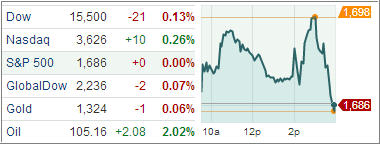Domestic equity markets finished the month on a mixed note following a relatively positive statement release by the Federal Reserve affirming no changes to current monetary policy and a stronger-than-expected private sector job report from ADP.
Stocks held slim gains into the afternoon when the latest policy directive from the Federal Open Market Committee sent the Nasdaq and S&P 500 to fresh highs. The two indices were unable to maintain those levels into the close as broad-based weakness pressured the major averages to their lows. The S&P500 Index finished July up 5 percent to mark its best month since January.
The Federal Reserve said that the U.S. economy is growing only modestly, a downgrade from its June assessment. The Fed expects growth will pick up in the second half of the year, but the more cautious message may be a signal that it’s not ready to slow its bond purchases soon. In a statement after a two-day policy meeting, the Fed says it will keep buying $85 billion a month in bonds to help lower long-term interest rates. It also said it plans to hold its key short-term rate at a record low near zero at least as long as the unemployment rate stays above 6.5 percent and the inflation outlook remains mild.
On a related note, the Commerce Department report earlier today showed that gross domestic product rose at a 1.7 percent annualized rate, after a 1.1 percent gain the prior quarter. The median forecast called for a 1 percent advance for last quarter. Consumer spending, the biggest part of the economy, climbed 1.8 percent.
Moreover, companies boosted employment by 200,000 workers in July, figures from the Roseland, New Jersey-based ADP Research Institute showed today, exceeding expectation of a 180,000 gain. Stocks mostly extended gains following these releases, led by consumer discretionary, energy and other growth sectors.
The relative strength of home builders helped the discretionary sector settle in the lead after the Fed suggested that it would be unlikely to engage in policy that would cause a further rise in rates. Retailers also outperformed climbing 0.3%.
Elsewhere, energy and industrials also displayed strength. The energy sector advanced 0.3% as crude oil rose 2.0% to $105.13 per barrel. At the same time, dividend-paying stocks such as utilities slipped. The final-hour selloff pressured cyclical sectors. With regard to defensive groups, telecom services and utilities ended with respective losses of 1.0% and 0.7% while consumer staples shed 0.2%, and health care ended little changed.
Our Trend Tracking Indexes (TTIs) headed slightly higher with the Domestic TTI edging to +3.29% while the International TTI ended the day at +6.37%.
Contact Ulli
